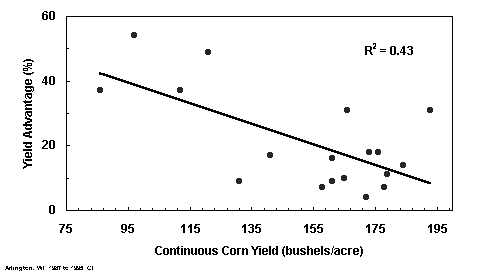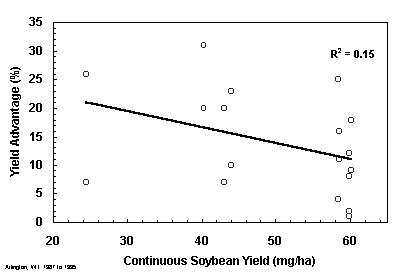How Important Is Crop Rotation In "Stress" Environments?
April 25, 1996 3(6):43-45
Joe Lauer and Ed Oplinger, Corn and Soybean Agronomists
Yield increases associated with crop rotation have often been referred to as the
"rotation effect." Often 10 to 15% yield increases are reported when corn
is rotated with other crops. Several workers have suggested that the rotation effect
is greater in "stress" environments than in normal growing seasons. For
the past 13 years, work has been conducted near Arlington, WI investigating long-term
rotation effects. A total of 14 treatments have investigated the following general
cropping sequences: a) 5-years of consecutive corn alternated with 5-years of consecutive
soybean; b) continuous corn and soybean; and c) annual rotation of each crop. The
experiment was begun in 1983 and required four years for the initial rotation sequences
to be established.
Corn yields were greater for the corn-soybean rotation and first-year corn cropping
sequence than for second-year corn, which also had higher yields than the remaining
4 cropping sequences (Fig. 1). The rotation effect lasted two years. In the third
and subsequent years of corn, yields were similar to continuous corn.


There was a linear relationship between the relative yield advantage of corn in
the annual rotation and first-year corn versus the yield of continuous corn (Fig.
2). As the yield of continuous corn increased (better environments), the yield advantage
of rotation declined. In low yielding environments, the yield advantage of first-year
corn following 5 years of continuous soybean and corn grown in annual rotation were
often greater than 30%; whereas in high yielding environments the yield advantage
for first-year corn and corn grown in annual rotation were generally less than 20%.
What is a "stress" environment? Between 1987 and 1995, high yielding corn
environments were characterized by high, but not excessive rainfall, temperatures,
and solar radiation during the growing season, while low yielding (stress) environments
occurred in the hottest, driest, and sunniest growing season (1988) and the coolest,
wettest, and cloudiest growing season (1993).
When averaged across all years, first-year soybeans following five years of corn
were the highest of any soybean cropping system sequence (Fig. 3). Continuous soybean
yields were greater than fifth-year soybean yields. Soybean yield in the corn-soybean
rotation was 5% greater than continuous soybeans. Second year soybean produced the
same as soybean rotated annually with corn, and these two cropping sequences yielded
more than third-, fourth-, and fifth-year soybean.


At Arlington, there was no relationship between the yield advantage of corn-soybean
rotation and first-year soybean following 5 years of continuous corn versus continuous
soybean regardless of the environment (Fig. 4).
These results show that the commonly practiced corn-soybean rotation optimizes corn
yields, but not soybean yields. For corn, the rotation effect was more pronounced
in low yielding environments than in high yielding environments.